BSBINN601: Lead and Manage Organisational Change Project Report
VerifiedAdded on 2022/08/12
|26
|5186
|20
Project
AI Summary
This project, completed for the BSBINN601 Lead and Manage Organisational Change course at Crown Institute, delves into the complexities of managing change within organizations. The project begins with an exploration of the key phases of a change management process, identifying the need for change, preparing a team, and implementing the change. It examines the reasons for organizational change, such as new technology, internal/external pressures, and product obsolescence, and utilizes force-field analysis to understand the factors supporting and opposing change. The project then analyzes the Burke-Litwin and Kotter's 8-step change models, highlighting their application in successful change initiatives. Strategies for communicating change, addressing external environmental impacts, and the importance of participative management are discussed. Components of a change management plan, reasons for resistance, and strategies to overcome resistance, including addressing barriers to change are also included. The project also includes a case study analysis of Samson Media, including best practices, a change management briefing report, communication plans, and a draft change management plan, and emails to the CEO and senior management.
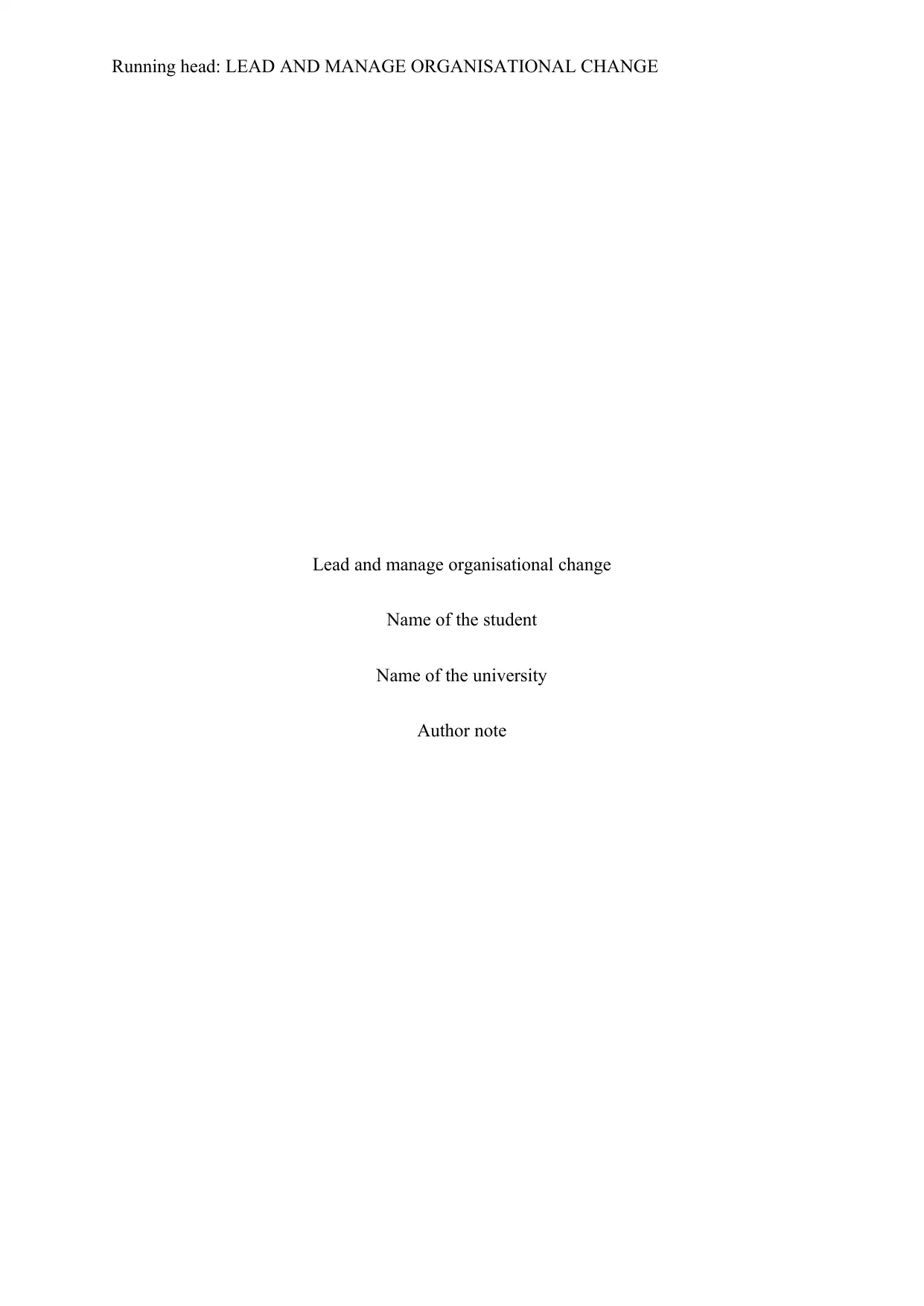
Running head: LEAD AND MANAGE ORGANISATIONAL CHANGE
Lead and manage organisational change
Name of the student
Name of the university
Author note
Lead and manage organisational change
Name of the student
Name of the university
Author note
Paraphrase This Document
Need a fresh take? Get an instant paraphrase of this document with our AI Paraphraser
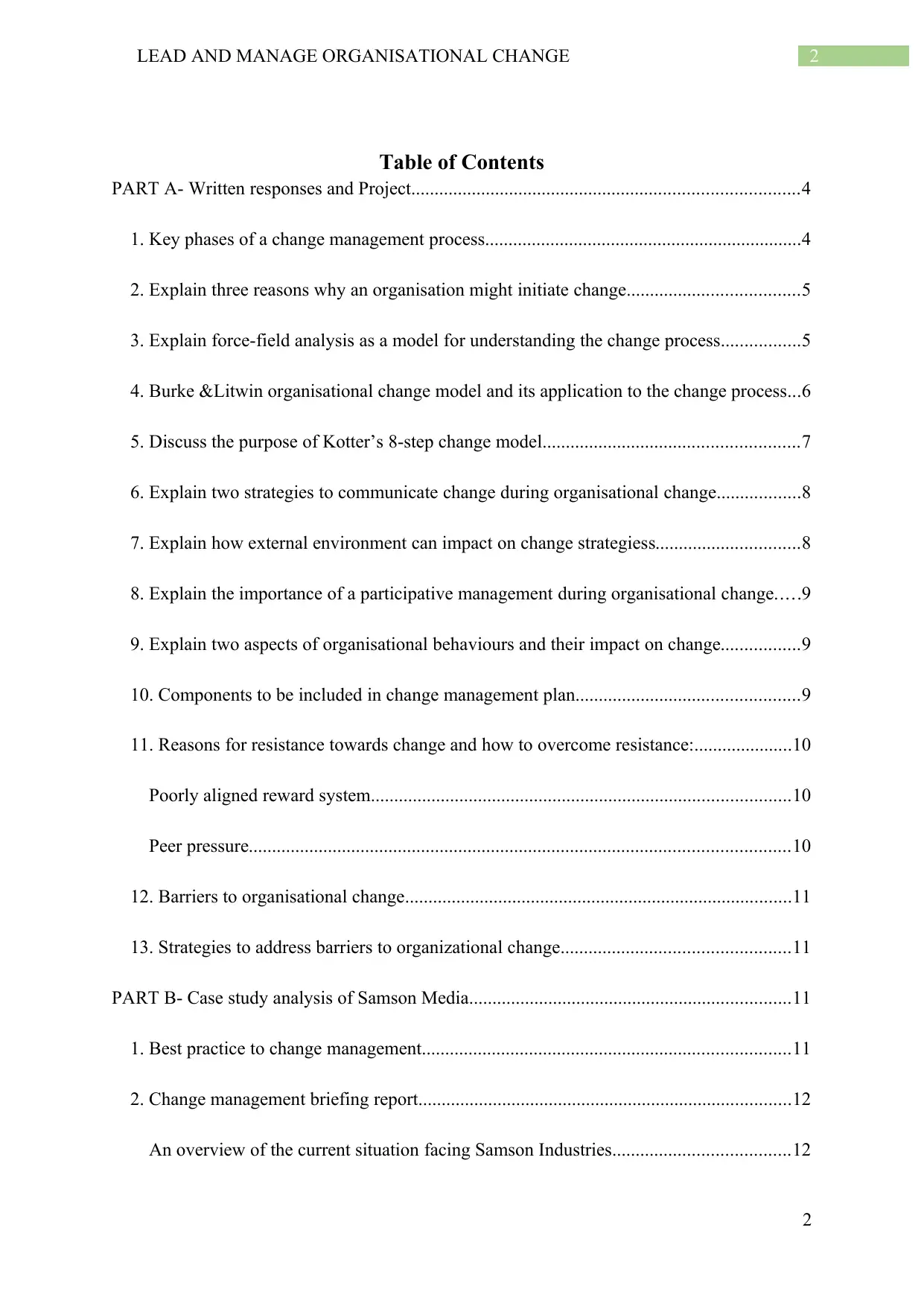
2LEAD AND MANAGE ORGANISATIONAL CHANGE
Table of Contents
PART A- Written responses and Project...................................................................................4
1. Key phases of a change management process....................................................................4
2. Explain three reasons why an organisation might initiate change.....................................5
3. Explain force-field analysis as a model for understanding the change process.................5
4. Burke &Litwin organisational change model and its application to the change process...6
5. Discuss the purpose of Kotter’s 8-step change model.......................................................7
6. Explain two strategies to communicate change during organisational change..................8
7. Explain how external environment can impact on change strategiess...............................8
8. Explain the importance of a participative management during organisational change.....9
9. Explain two aspects of organisational behaviours and their impact on change.................9
10. Components to be included in change management plan................................................9
11. Reasons for resistance towards change and how to overcome resistance:.....................10
Poorly aligned reward system..........................................................................................10
Peer pressure....................................................................................................................10
12. Barriers to organisational change...................................................................................11
13. Strategies to address barriers to organizational change.................................................11
PART B- Case study analysis of Samson Media.....................................................................11
1. Best practice to change management...............................................................................11
2. Change management briefing report................................................................................12
An overview of the current situation facing Samson Industries......................................12
2
Table of Contents
PART A- Written responses and Project...................................................................................4
1. Key phases of a change management process....................................................................4
2. Explain three reasons why an organisation might initiate change.....................................5
3. Explain force-field analysis as a model for understanding the change process.................5
4. Burke &Litwin organisational change model and its application to the change process...6
5. Discuss the purpose of Kotter’s 8-step change model.......................................................7
6. Explain two strategies to communicate change during organisational change..................8
7. Explain how external environment can impact on change strategiess...............................8
8. Explain the importance of a participative management during organisational change.....9
9. Explain two aspects of organisational behaviours and their impact on change.................9
10. Components to be included in change management plan................................................9
11. Reasons for resistance towards change and how to overcome resistance:.....................10
Poorly aligned reward system..........................................................................................10
Peer pressure....................................................................................................................10
12. Barriers to organisational change...................................................................................11
13. Strategies to address barriers to organizational change.................................................11
PART B- Case study analysis of Samson Media.....................................................................11
1. Best practice to change management...............................................................................11
2. Change management briefing report................................................................................12
An overview of the current situation facing Samson Industries......................................12
2
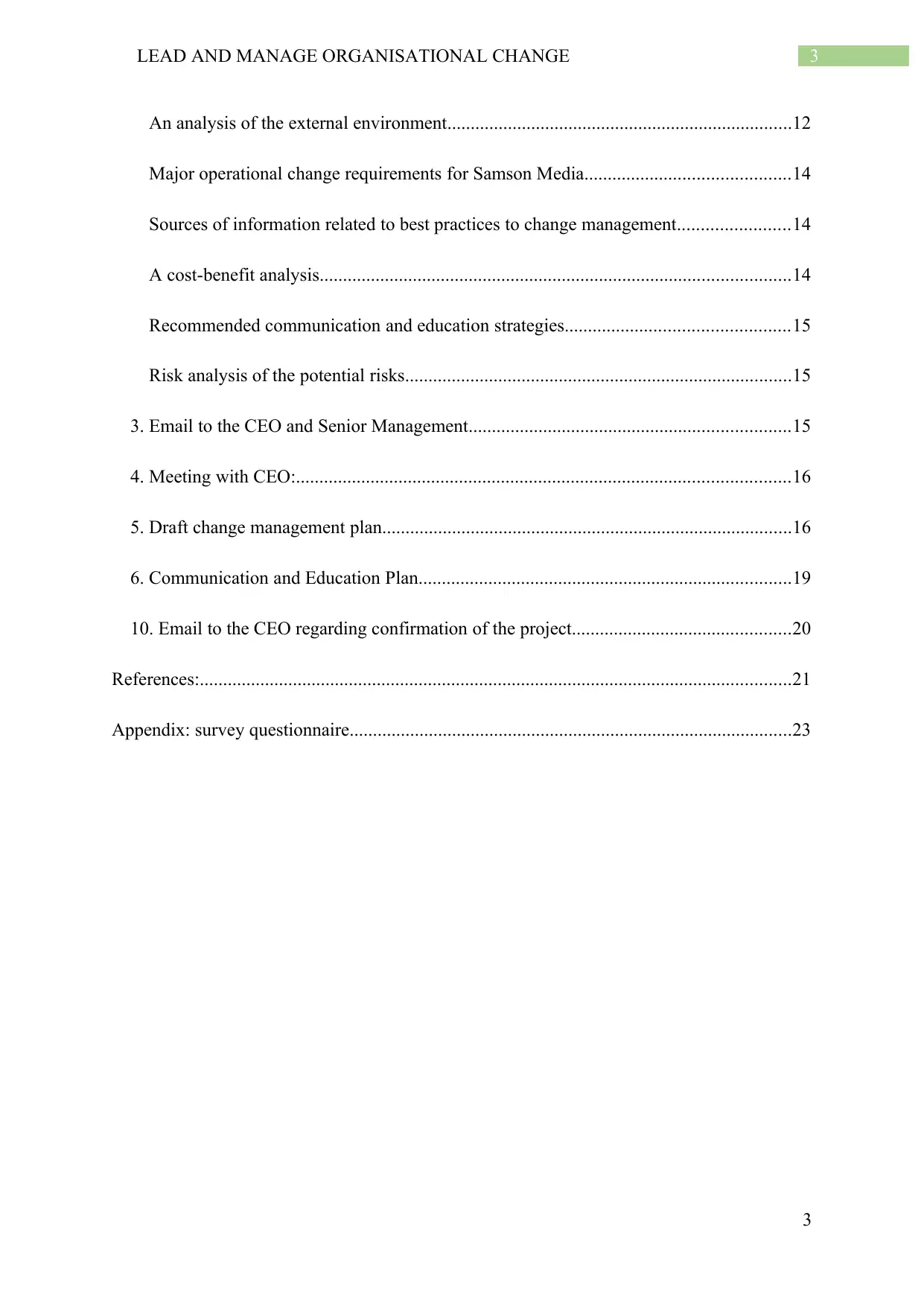
3LEAD AND MANAGE ORGANISATIONAL CHANGE
An analysis of the external environment..........................................................................12
Major operational change requirements for Samson Media............................................14
Sources of information related to best practices to change management........................14
A cost-benefit analysis.....................................................................................................14
Recommended communication and education strategies................................................15
Risk analysis of the potential risks...................................................................................15
3. Email to the CEO and Senior Management.....................................................................15
4. Meeting with CEO:..........................................................................................................16
5. Draft change management plan........................................................................................16
6. Communication and Education Plan................................................................................19
10. Email to the CEO regarding confirmation of the project...............................................20
References:...............................................................................................................................21
Appendix: survey questionnaire...............................................................................................23
3
An analysis of the external environment..........................................................................12
Major operational change requirements for Samson Media............................................14
Sources of information related to best practices to change management........................14
A cost-benefit analysis.....................................................................................................14
Recommended communication and education strategies................................................15
Risk analysis of the potential risks...................................................................................15
3. Email to the CEO and Senior Management.....................................................................15
4. Meeting with CEO:..........................................................................................................16
5. Draft change management plan........................................................................................16
6. Communication and Education Plan................................................................................19
10. Email to the CEO regarding confirmation of the project...............................................20
References:...............................................................................................................................21
Appendix: survey questionnaire...............................................................................................23
3
⊘ This is a preview!⊘
Do you want full access?
Subscribe today to unlock all pages.

Trusted by 1+ million students worldwide
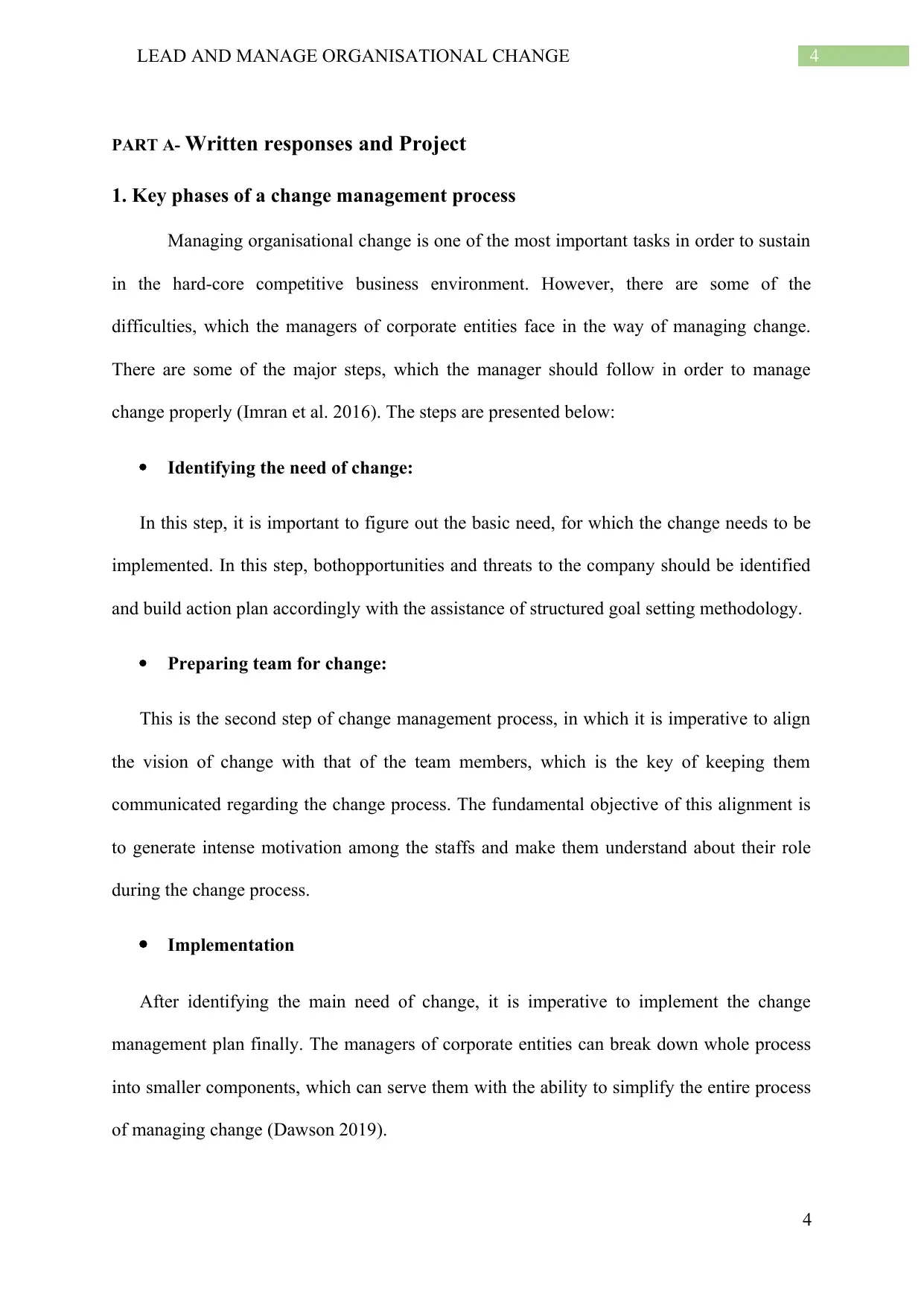
4LEAD AND MANAGE ORGANISATIONAL CHANGE
PART A- Written responses and Project
1. Key phases of a change management process
Managing organisational change is one of the most important tasks in order to sustain
in the hard-core competitive business environment. However, there are some of the
difficulties, which the managers of corporate entities face in the way of managing change.
There are some of the major steps, which the manager should follow in order to manage
change properly (Imran et al. 2016). The steps are presented below:
Identifying the need of change:
In this step, it is important to figure out the basic need, for which the change needs to be
implemented. In this step, bothopportunities and threats to the company should be identified
and build action plan accordingly with the assistance of structured goal setting methodology.
Preparing team for change:
This is the second step of change management process, in which it is imperative to align
the vision of change with that of the team members, which is the key of keeping them
communicated regarding the change process. The fundamental objective of this alignment is
to generate intense motivation among the staffs and make them understand about their role
during the change process.
Implementation
After identifying the main need of change, it is imperative to implement the change
management plan finally. The managers of corporate entities can break down whole process
into smaller components, which can serve them with the ability to simplify the entire process
of managing change (Dawson 2019).
4
PART A- Written responses and Project
1. Key phases of a change management process
Managing organisational change is one of the most important tasks in order to sustain
in the hard-core competitive business environment. However, there are some of the
difficulties, which the managers of corporate entities face in the way of managing change.
There are some of the major steps, which the manager should follow in order to manage
change properly (Imran et al. 2016). The steps are presented below:
Identifying the need of change:
In this step, it is important to figure out the basic need, for which the change needs to be
implemented. In this step, bothopportunities and threats to the company should be identified
and build action plan accordingly with the assistance of structured goal setting methodology.
Preparing team for change:
This is the second step of change management process, in which it is imperative to align
the vision of change with that of the team members, which is the key of keeping them
communicated regarding the change process. The fundamental objective of this alignment is
to generate intense motivation among the staffs and make them understand about their role
during the change process.
Implementation
After identifying the main need of change, it is imperative to implement the change
management plan finally. The managers of corporate entities can break down whole process
into smaller components, which can serve them with the ability to simplify the entire process
of managing change (Dawson 2019).
4
Paraphrase This Document
Need a fresh take? Get an instant paraphrase of this document with our AI Paraphraser
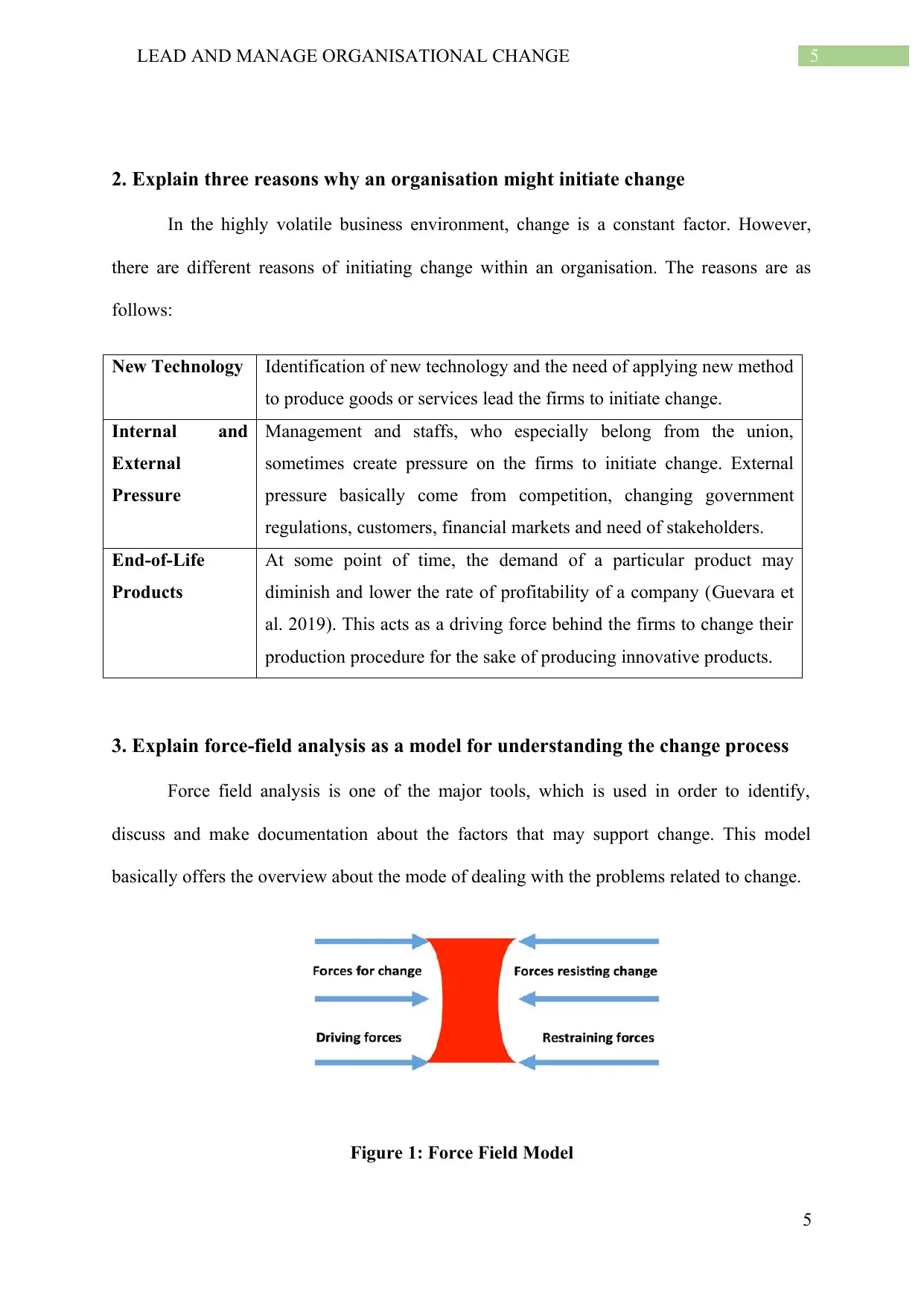
5LEAD AND MANAGE ORGANISATIONAL CHANGE
2. Explain three reasons why an organisation might initiate change
In the highly volatile business environment, change is a constant factor. However,
there are different reasons of initiating change within an organisation. The reasons are as
follows:
New Technology Identification of new technology and the need of applying new method
to produce goods or services lead the firms to initiate change.
Internal and
External
Pressure
Management and staffs, who especially belong from the union,
sometimes create pressure on the firms to initiate change. External
pressure basically come from competition, changing government
regulations, customers, financial markets and need of stakeholders.
End-of-Life
Products
At some point of time, the demand of a particular product may
diminish and lower the rate of profitability of a company (Guevara et
al. 2019). This acts as a driving force behind the firms to change their
production procedure for the sake of producing innovative products.
3. Explain force-field analysis as a model for understanding the change process
Force field analysis is one of the major tools, which is used in order to identify,
discuss and make documentation about the factors that may support change. This model
basically offers the overview about the mode of dealing with the problems related to change.
Figure 1: Force Field Model
5
2. Explain three reasons why an organisation might initiate change
In the highly volatile business environment, change is a constant factor. However,
there are different reasons of initiating change within an organisation. The reasons are as
follows:
New Technology Identification of new technology and the need of applying new method
to produce goods or services lead the firms to initiate change.
Internal and
External
Pressure
Management and staffs, who especially belong from the union,
sometimes create pressure on the firms to initiate change. External
pressure basically come from competition, changing government
regulations, customers, financial markets and need of stakeholders.
End-of-Life
Products
At some point of time, the demand of a particular product may
diminish and lower the rate of profitability of a company (Guevara et
al. 2019). This acts as a driving force behind the firms to change their
production procedure for the sake of producing innovative products.
3. Explain force-field analysis as a model for understanding the change process
Force field analysis is one of the major tools, which is used in order to identify,
discuss and make documentation about the factors that may support change. This model
basically offers the overview about the mode of dealing with the problems related to change.
Figure 1: Force Field Model
5
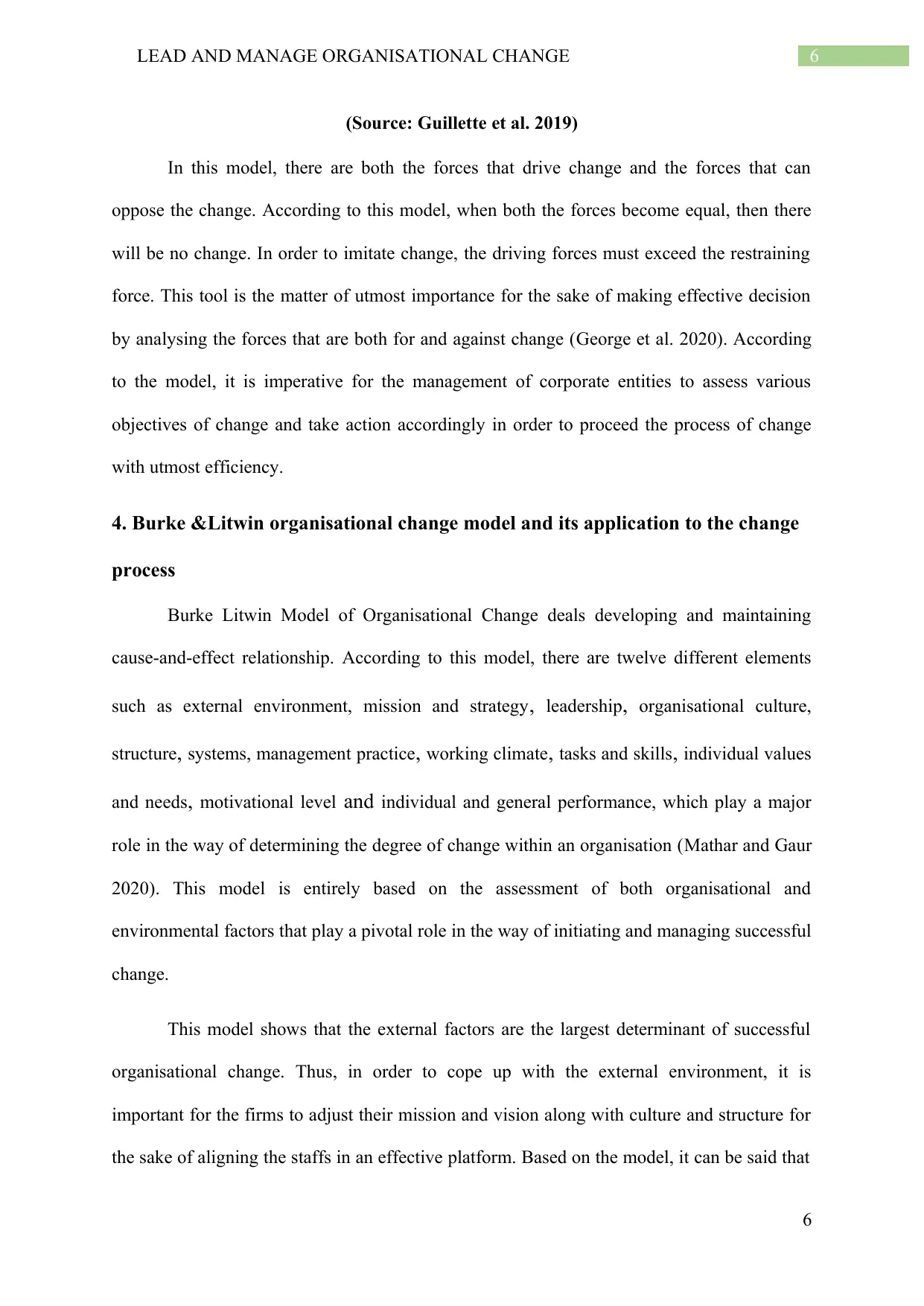
6LEAD AND MANAGE ORGANISATIONAL CHANGE
(Source: Guillette et al. 2019)
In this model, there are both the forces that drive change and the forces that can
oppose the change. According to this model, when both the forces become equal, then there
will be no change. In order to imitate change, the driving forces must exceed the restraining
force. This tool is the matter of utmost importance for the sake of making effective decision
by analysing the forces that are both for and against change (George et al. 2020). According
to the model, it is imperative for the management of corporate entities to assess various
objectives of change and take action accordingly in order to proceed the process of change
with utmost efficiency.
4. Burke &Litwin organisational change model and its application to the change
process
Burke Litwin Model of Organisational Change deals developing and maintaining
cause-and-effect relationship. According to this model, there are twelve different elements
such as external environment, mission and strategy, leadership, organisational culture,
structure, systems, management practice, working climate, tasks and skills, individual values
and needs, motivational level and individual and general performance, which play a major
role in the way of determining the degree of change within an organisation (Mathar and Gaur
2020). This model is entirely based on the assessment of both organisational and
environmental factors that play a pivotal role in the way of initiating and managing successful
change.
This model shows that the external factors are the largest determinant of successful
organisational change. Thus, in order to cope up with the external environment, it is
important for the firms to adjust their mission and vision along with culture and structure for
the sake of aligning the staffs in an effective platform. Based on the model, it can be said that
6
(Source: Guillette et al. 2019)
In this model, there are both the forces that drive change and the forces that can
oppose the change. According to this model, when both the forces become equal, then there
will be no change. In order to imitate change, the driving forces must exceed the restraining
force. This tool is the matter of utmost importance for the sake of making effective decision
by analysing the forces that are both for and against change (George et al. 2020). According
to the model, it is imperative for the management of corporate entities to assess various
objectives of change and take action accordingly in order to proceed the process of change
with utmost efficiency.
4. Burke &Litwin organisational change model and its application to the change
process
Burke Litwin Model of Organisational Change deals developing and maintaining
cause-and-effect relationship. According to this model, there are twelve different elements
such as external environment, mission and strategy, leadership, organisational culture,
structure, systems, management practice, working climate, tasks and skills, individual values
and needs, motivational level and individual and general performance, which play a major
role in the way of determining the degree of change within an organisation (Mathar and Gaur
2020). This model is entirely based on the assessment of both organisational and
environmental factors that play a pivotal role in the way of initiating and managing successful
change.
This model shows that the external factors are the largest determinant of successful
organisational change. Thus, in order to cope up with the external environment, it is
important for the firms to adjust their mission and vision along with culture and structure for
the sake of aligning the staffs in an effective platform. Based on the model, it can be said that
6
⊘ This is a preview!⊘
Do you want full access?
Subscribe today to unlock all pages.

Trusted by 1+ million students worldwide
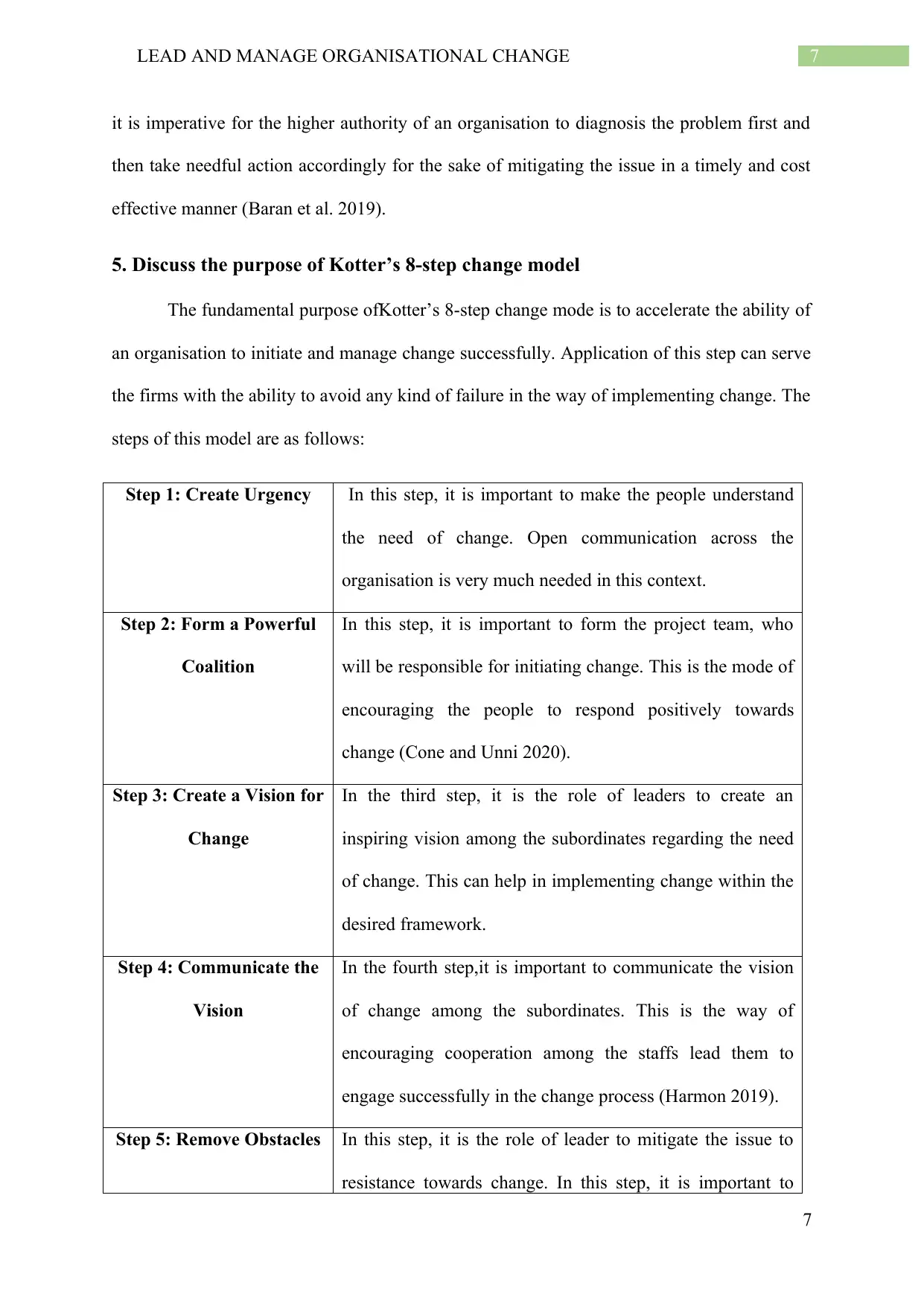
7LEAD AND MANAGE ORGANISATIONAL CHANGE
it is imperative for the higher authority of an organisation to diagnosis the problem first and
then take needful action accordingly for the sake of mitigating the issue in a timely and cost
effective manner (Baran et al. 2019).
5. Discuss the purpose of Kotter’s 8-step change model
The fundamental purpose ofKotter’s 8-step change mode is to accelerate the ability of
an organisation to initiate and manage change successfully. Application of this step can serve
the firms with the ability to avoid any kind of failure in the way of implementing change. The
steps of this model are as follows:
Step 1: Create Urgency In this step, it is important to make the people understand
the need of change. Open communication across the
organisation is very much needed in this context.
Step 2: Form a Powerful
Coalition
In this step, it is important to form the project team, who
will be responsible for initiating change. This is the mode of
encouraging the people to respond positively towards
change (Cone and Unni 2020).
Step 3: Create a Vision for
Change
In the third step, it is the role of leaders to create an
inspiring vision among the subordinates regarding the need
of change. This can help in implementing change within the
desired framework.
Step 4: Communicate the
Vision
In the fourth step,it is important to communicate the vision
of change among the subordinates. This is the way of
encouraging cooperation among the staffs lead them to
engage successfully in the change process (Harmon 2019).
Step 5: Remove Obstacles In this step, it is the role of leader to mitigate the issue to
resistance towards change. In this step, it is important to
7
it is imperative for the higher authority of an organisation to diagnosis the problem first and
then take needful action accordingly for the sake of mitigating the issue in a timely and cost
effective manner (Baran et al. 2019).
5. Discuss the purpose of Kotter’s 8-step change model
The fundamental purpose ofKotter’s 8-step change mode is to accelerate the ability of
an organisation to initiate and manage change successfully. Application of this step can serve
the firms with the ability to avoid any kind of failure in the way of implementing change. The
steps of this model are as follows:
Step 1: Create Urgency In this step, it is important to make the people understand
the need of change. Open communication across the
organisation is very much needed in this context.
Step 2: Form a Powerful
Coalition
In this step, it is important to form the project team, who
will be responsible for initiating change. This is the mode of
encouraging the people to respond positively towards
change (Cone and Unni 2020).
Step 3: Create a Vision for
Change
In the third step, it is the role of leaders to create an
inspiring vision among the subordinates regarding the need
of change. This can help in implementing change within the
desired framework.
Step 4: Communicate the
Vision
In the fourth step,it is important to communicate the vision
of change among the subordinates. This is the way of
encouraging cooperation among the staffs lead them to
engage successfully in the change process (Harmon 2019).
Step 5: Remove Obstacles In this step, it is the role of leader to mitigate the issue to
resistance towards change. In this step, it is important to
7
Paraphrase This Document
Need a fresh take? Get an instant paraphrase of this document with our AI Paraphraser
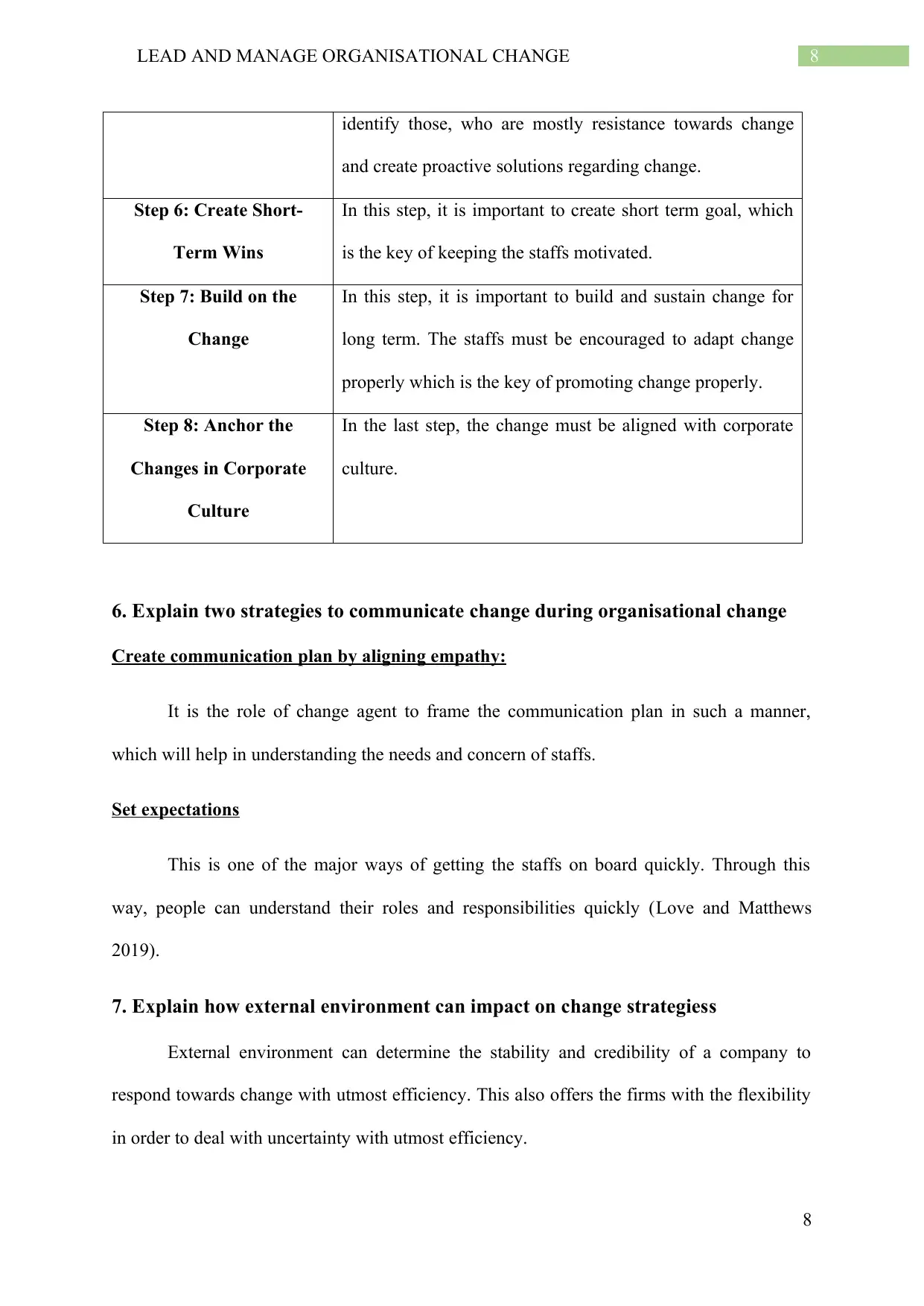
8LEAD AND MANAGE ORGANISATIONAL CHANGE
identify those, who are mostly resistance towards change
and create proactive solutions regarding change.
Step 6: Create Short-
Term Wins
In this step, it is important to create short term goal, which
is the key of keeping the staffs motivated.
Step 7: Build on the
Change
In this step, it is important to build and sustain change for
long term. The staffs must be encouraged to adapt change
properly which is the key of promoting change properly.
Step 8: Anchor the
Changes in Corporate
Culture
In the last step, the change must be aligned with corporate
culture.
6. Explain two strategies to communicate change during organisational change
Create communication plan by aligning empathy:
It is the role of change agent to frame the communication plan in such a manner,
which will help in understanding the needs and concern of staffs.
Set expectations
This is one of the major ways of getting the staffs on board quickly. Through this
way, people can understand their roles and responsibilities quickly (Love and Matthews
2019).
7. Explain how external environment can impact on change strategiess
External environment can determine the stability and credibility of a company to
respond towards change with utmost efficiency. This also offers the firms with the flexibility
in order to deal with uncertainty with utmost efficiency.
8
identify those, who are mostly resistance towards change
and create proactive solutions regarding change.
Step 6: Create Short-
Term Wins
In this step, it is important to create short term goal, which
is the key of keeping the staffs motivated.
Step 7: Build on the
Change
In this step, it is important to build and sustain change for
long term. The staffs must be encouraged to adapt change
properly which is the key of promoting change properly.
Step 8: Anchor the
Changes in Corporate
Culture
In the last step, the change must be aligned with corporate
culture.
6. Explain two strategies to communicate change during organisational change
Create communication plan by aligning empathy:
It is the role of change agent to frame the communication plan in such a manner,
which will help in understanding the needs and concern of staffs.
Set expectations
This is one of the major ways of getting the staffs on board quickly. Through this
way, people can understand their roles and responsibilities quickly (Love and Matthews
2019).
7. Explain how external environment can impact on change strategiess
External environment can determine the stability and credibility of a company to
respond towards change with utmost efficiency. This also offers the firms with the flexibility
in order to deal with uncertainty with utmost efficiency.
8
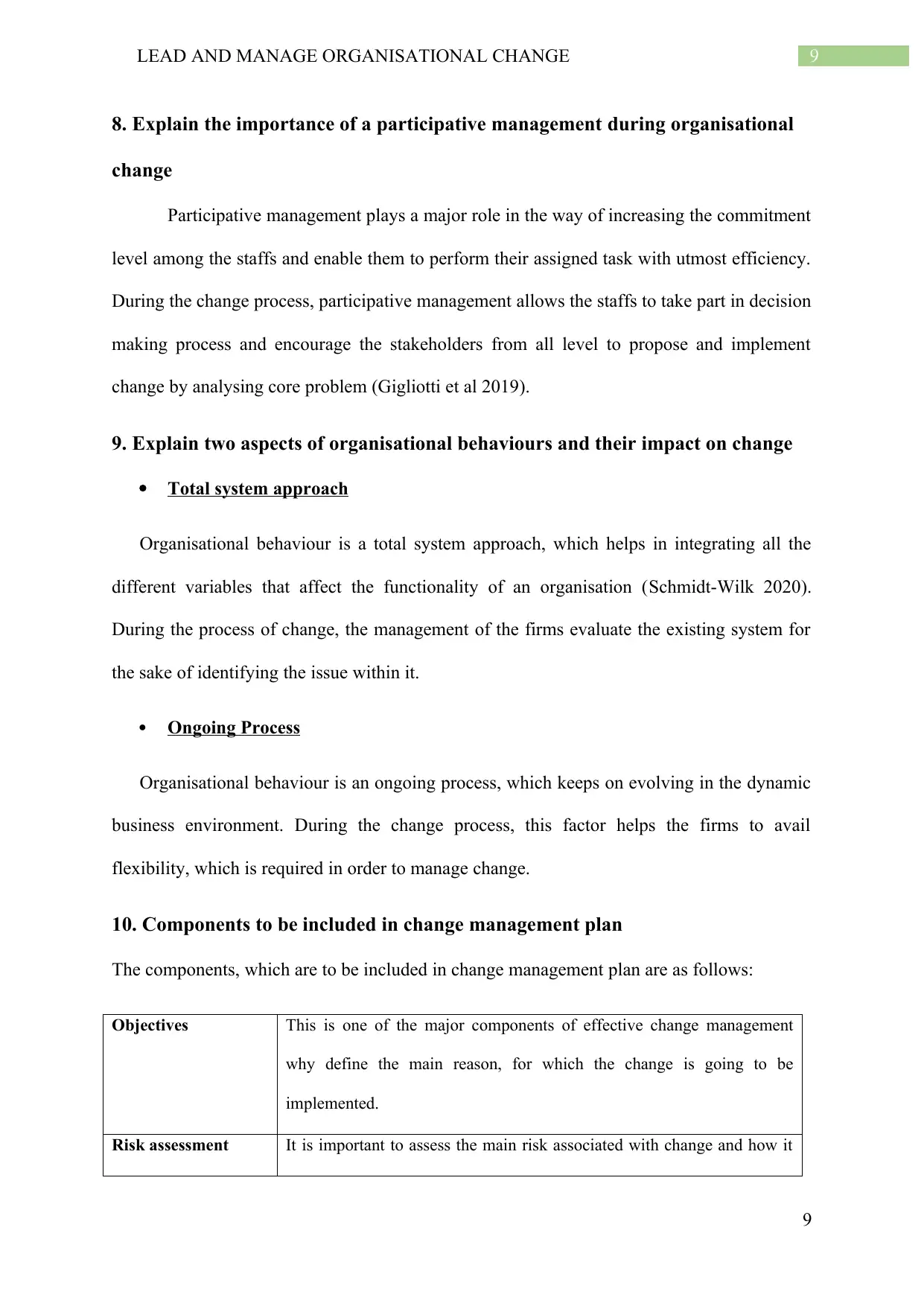
9LEAD AND MANAGE ORGANISATIONAL CHANGE
8. Explain the importance of a participative management during organisational
change
Participative management plays a major role in the way of increasing the commitment
level among the staffs and enable them to perform their assigned task with utmost efficiency.
During the change process, participative management allows the staffs to take part in decision
making process and encourage the stakeholders from all level to propose and implement
change by analysing core problem (Gigliotti et al 2019).
9. Explain two aspects of organisational behaviours and their impact on change
Total system approach
Organisational behaviour is a total system approach, which helps in integrating all the
different variables that affect the functionality of an organisation (Schmidt-Wilk 2020).
During the process of change, the management of the firms evaluate the existing system for
the sake of identifying the issue within it.
Ongoing Process
Organisational behaviour is an ongoing process, which keeps on evolving in the dynamic
business environment. During the change process, this factor helps the firms to avail
flexibility, which is required in order to manage change.
10. Components to be included in change management plan
The components, which are to be included in change management plan are as follows:
Objectives This is one of the major components of effective change management
why define the main reason, for which the change is going to be
implemented.
Risk assessment It is important to assess the main risk associated with change and how it
9
8. Explain the importance of a participative management during organisational
change
Participative management plays a major role in the way of increasing the commitment
level among the staffs and enable them to perform their assigned task with utmost efficiency.
During the change process, participative management allows the staffs to take part in decision
making process and encourage the stakeholders from all level to propose and implement
change by analysing core problem (Gigliotti et al 2019).
9. Explain two aspects of organisational behaviours and their impact on change
Total system approach
Organisational behaviour is a total system approach, which helps in integrating all the
different variables that affect the functionality of an organisation (Schmidt-Wilk 2020).
During the process of change, the management of the firms evaluate the existing system for
the sake of identifying the issue within it.
Ongoing Process
Organisational behaviour is an ongoing process, which keeps on evolving in the dynamic
business environment. During the change process, this factor helps the firms to avail
flexibility, which is required in order to manage change.
10. Components to be included in change management plan
The components, which are to be included in change management plan are as follows:
Objectives This is one of the major components of effective change management
why define the main reason, for which the change is going to be
implemented.
Risk assessment It is important to assess the main risk associated with change and how it
9
⊘ This is a preview!⊘
Do you want full access?
Subscribe today to unlock all pages.

Trusted by 1+ million students worldwide
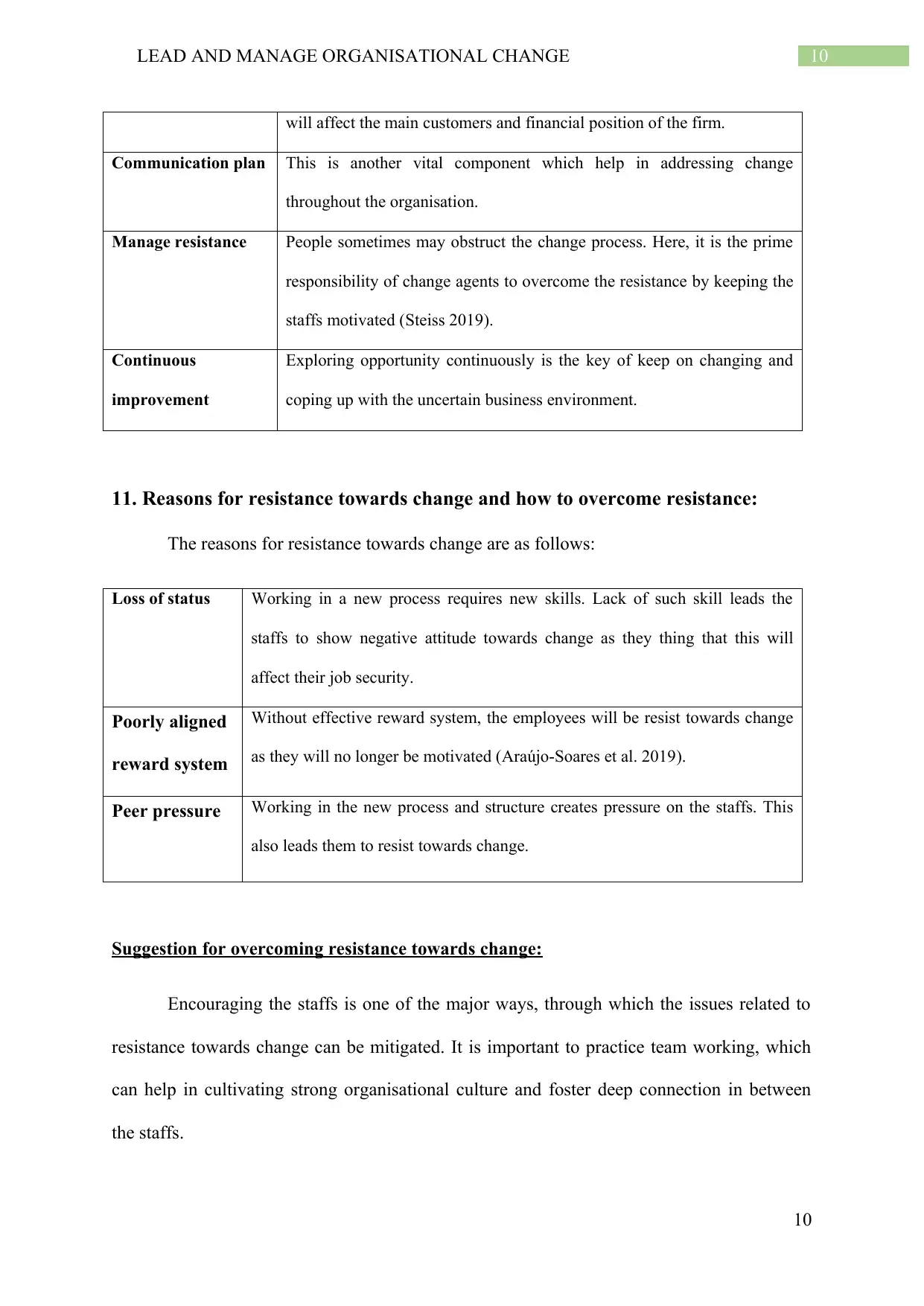
10LEAD AND MANAGE ORGANISATIONAL CHANGE
will affect the main customers and financial position of the firm.
Communication plan This is another vital component which help in addressing change
throughout the organisation.
Manage resistance People sometimes may obstruct the change process. Here, it is the prime
responsibility of change agents to overcome the resistance by keeping the
staffs motivated (Steiss 2019).
Continuous
improvement
Exploring opportunity continuously is the key of keep on changing and
coping up with the uncertain business environment.
11. Reasons for resistance towards change and how to overcome resistance:
The reasons for resistance towards change are as follows:
Loss of status Working in a new process requires new skills. Lack of such skill leads the
staffs to show negative attitude towards change as they thing that this will
affect their job security.
Poorly aligned
reward system
Without effective reward system, the employees will be resist towards change
as they will no longer be motivated (Araújo-Soares et al. 2019).
Peer pressure Working in the new process and structure creates pressure on the staffs. This
also leads them to resist towards change.
Suggestion for overcoming resistance towards change:
Encouraging the staffs is one of the major ways, through which the issues related to
resistance towards change can be mitigated. It is important to practice team working, which
can help in cultivating strong organisational culture and foster deep connection in between
the staffs.
10
will affect the main customers and financial position of the firm.
Communication plan This is another vital component which help in addressing change
throughout the organisation.
Manage resistance People sometimes may obstruct the change process. Here, it is the prime
responsibility of change agents to overcome the resistance by keeping the
staffs motivated (Steiss 2019).
Continuous
improvement
Exploring opportunity continuously is the key of keep on changing and
coping up with the uncertain business environment.
11. Reasons for resistance towards change and how to overcome resistance:
The reasons for resistance towards change are as follows:
Loss of status Working in a new process requires new skills. Lack of such skill leads the
staffs to show negative attitude towards change as they thing that this will
affect their job security.
Poorly aligned
reward system
Without effective reward system, the employees will be resist towards change
as they will no longer be motivated (Araújo-Soares et al. 2019).
Peer pressure Working in the new process and structure creates pressure on the staffs. This
also leads them to resist towards change.
Suggestion for overcoming resistance towards change:
Encouraging the staffs is one of the major ways, through which the issues related to
resistance towards change can be mitigated. It is important to practice team working, which
can help in cultivating strong organisational culture and foster deep connection in between
the staffs.
10
Paraphrase This Document
Need a fresh take? Get an instant paraphrase of this document with our AI Paraphraser
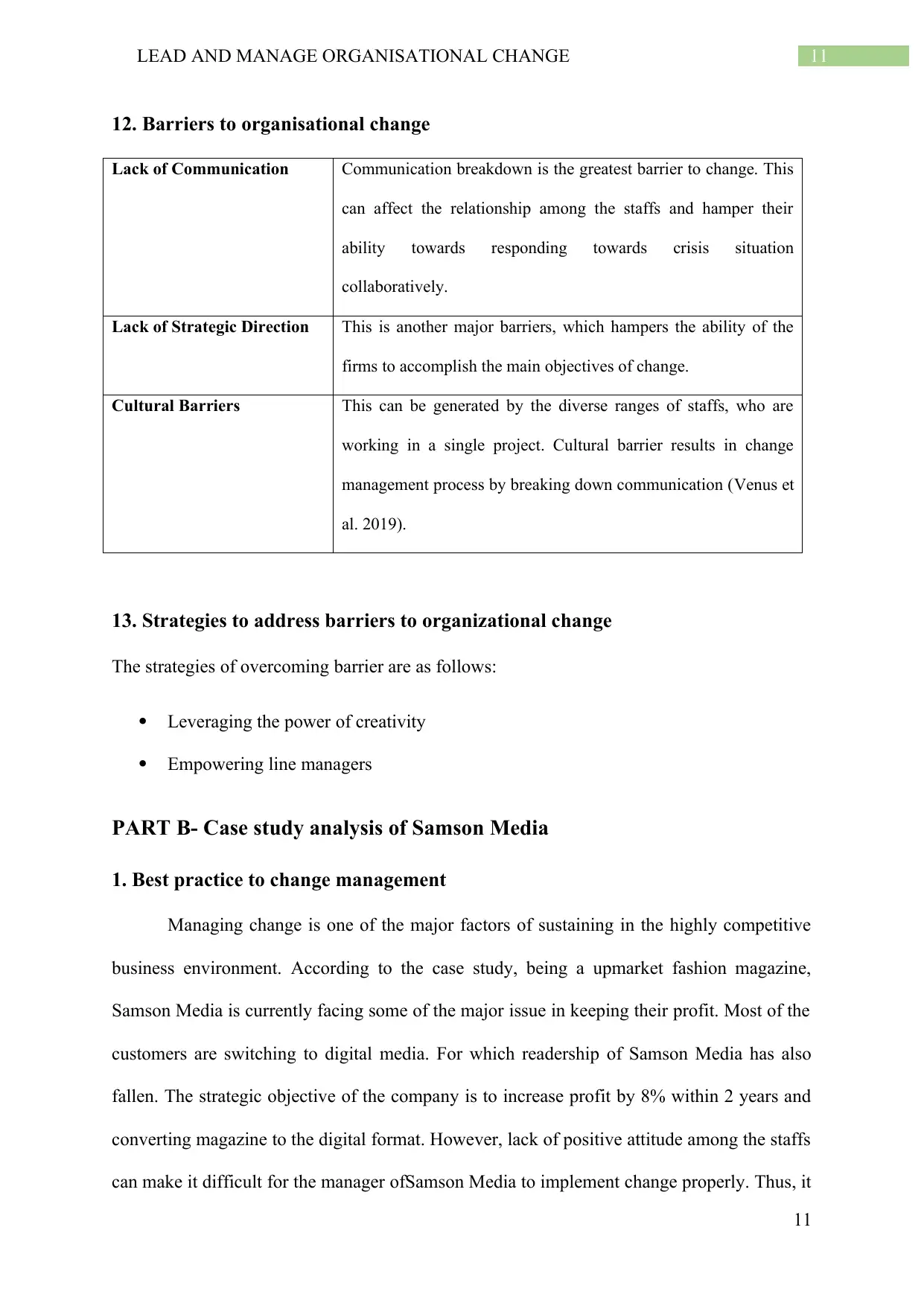
11LEAD AND MANAGE ORGANISATIONAL CHANGE
12. Barriers to organisational change
Lack of Communication Communication breakdown is the greatest barrier to change. This
can affect the relationship among the staffs and hamper their
ability towards responding towards crisis situation
collaboratively.
Lack of Strategic Direction This is another major barriers, which hampers the ability of the
firms to accomplish the main objectives of change.
Cultural Barriers This can be generated by the diverse ranges of staffs, who are
working in a single project. Cultural barrier results in change
management process by breaking down communication (Venus et
al. 2019).
13. Strategies to address barriers to organizational change
The strategies of overcoming barrier are as follows:
Leveraging the power of creativity
Empowering line managers
PART B- Case study analysis of Samson Media
1. Best practice to change management
Managing change is one of the major factors of sustaining in the highly competitive
business environment. According to the case study, being a upmarket fashion magazine,
Samson Media is currently facing some of the major issue in keeping their profit. Most of the
customers are switching to digital media. For which readership of Samson Media has also
fallen. The strategic objective of the company is to increase profit by 8% within 2 years and
converting magazine to the digital format. However, lack of positive attitude among the staffs
can make it difficult for the manager ofSamson Media to implement change properly. Thus, it
11
12. Barriers to organisational change
Lack of Communication Communication breakdown is the greatest barrier to change. This
can affect the relationship among the staffs and hamper their
ability towards responding towards crisis situation
collaboratively.
Lack of Strategic Direction This is another major barriers, which hampers the ability of the
firms to accomplish the main objectives of change.
Cultural Barriers This can be generated by the diverse ranges of staffs, who are
working in a single project. Cultural barrier results in change
management process by breaking down communication (Venus et
al. 2019).
13. Strategies to address barriers to organizational change
The strategies of overcoming barrier are as follows:
Leveraging the power of creativity
Empowering line managers
PART B- Case study analysis of Samson Media
1. Best practice to change management
Managing change is one of the major factors of sustaining in the highly competitive
business environment. According to the case study, being a upmarket fashion magazine,
Samson Media is currently facing some of the major issue in keeping their profit. Most of the
customers are switching to digital media. For which readership of Samson Media has also
fallen. The strategic objective of the company is to increase profit by 8% within 2 years and
converting magazine to the digital format. However, lack of positive attitude among the staffs
can make it difficult for the manager ofSamson Media to implement change properly. Thus, it
11
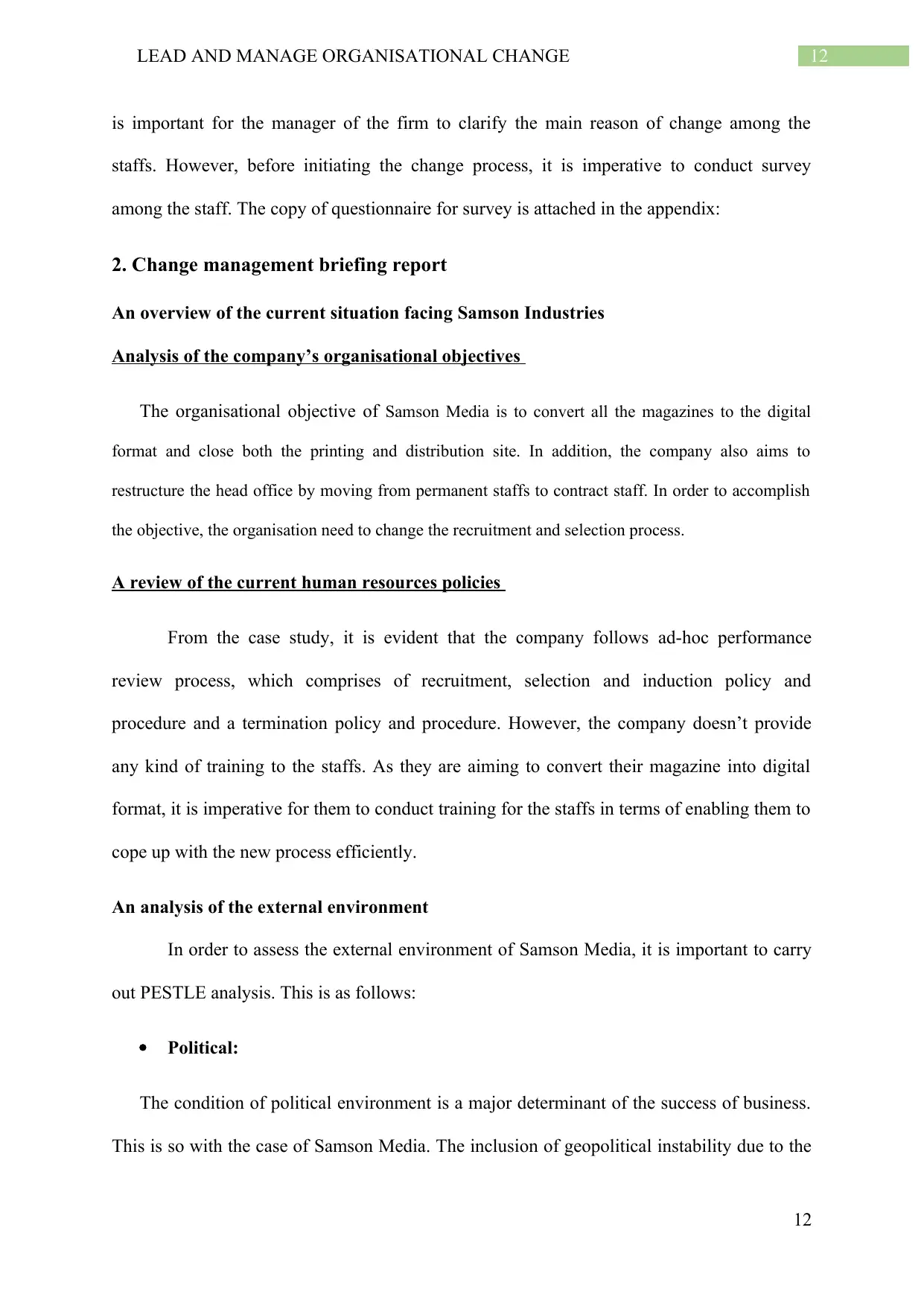
12LEAD AND MANAGE ORGANISATIONAL CHANGE
is important for the manager of the firm to clarify the main reason of change among the
staffs. However, before initiating the change process, it is imperative to conduct survey
among the staff. The copy of questionnaire for survey is attached in the appendix:
2. Change management briefing report
An overview of the current situation facing Samson Industries
Analysis of the company’s organisational objectives
The organisational objective of Samson Media is to convert all the magazines to the digital
format and close both the printing and distribution site. In addition, the company also aims to
restructure the head office by moving from permanent staffs to contract staff. In order to accomplish
the objective, the organisation need to change the recruitment and selection process.
A review of the current human resources policies
From the case study, it is evident that the company follows ad-hoc performance
review process, which comprises of recruitment, selection and induction policy and
procedure and a termination policy and procedure. However, the company doesn’t provide
any kind of training to the staffs. As they are aiming to convert their magazine into digital
format, it is imperative for them to conduct training for the staffs in terms of enabling them to
cope up with the new process efficiently.
An analysis of the external environment
In order to assess the external environment of Samson Media, it is important to carry
out PESTLE analysis. This is as follows:
Political:
The condition of political environment is a major determinant of the success of business.
This is so with the case of Samson Media. The inclusion of geopolitical instability due to the
12
is important for the manager of the firm to clarify the main reason of change among the
staffs. However, before initiating the change process, it is imperative to conduct survey
among the staff. The copy of questionnaire for survey is attached in the appendix:
2. Change management briefing report
An overview of the current situation facing Samson Industries
Analysis of the company’s organisational objectives
The organisational objective of Samson Media is to convert all the magazines to the digital
format and close both the printing and distribution site. In addition, the company also aims to
restructure the head office by moving from permanent staffs to contract staff. In order to accomplish
the objective, the organisation need to change the recruitment and selection process.
A review of the current human resources policies
From the case study, it is evident that the company follows ad-hoc performance
review process, which comprises of recruitment, selection and induction policy and
procedure and a termination policy and procedure. However, the company doesn’t provide
any kind of training to the staffs. As they are aiming to convert their magazine into digital
format, it is imperative for them to conduct training for the staffs in terms of enabling them to
cope up with the new process efficiently.
An analysis of the external environment
In order to assess the external environment of Samson Media, it is important to carry
out PESTLE analysis. This is as follows:
Political:
The condition of political environment is a major determinant of the success of business.
This is so with the case of Samson Media. The inclusion of geopolitical instability due to the
12
⊘ This is a preview!⊘
Do you want full access?
Subscribe today to unlock all pages.

Trusted by 1+ million students worldwide
1 out of 26
Related Documents
Your All-in-One AI-Powered Toolkit for Academic Success.
+13062052269
info@desklib.com
Available 24*7 on WhatsApp / Email
![[object Object]](/_next/static/media/star-bottom.7253800d.svg)
Unlock your academic potential
Copyright © 2020–2025 A2Z Services. All Rights Reserved. Developed and managed by ZUCOL.





